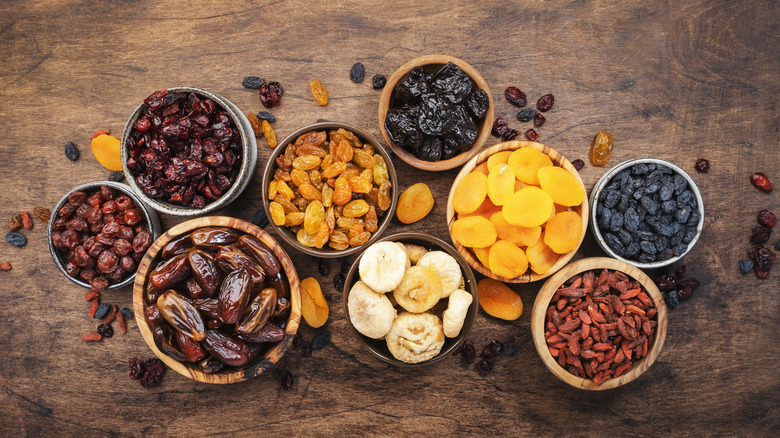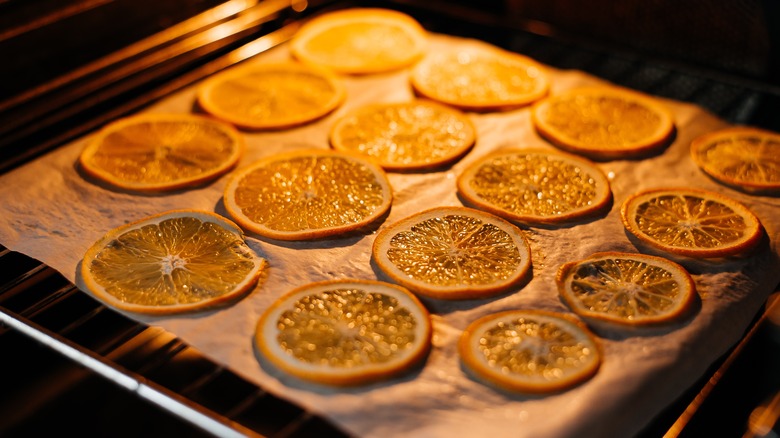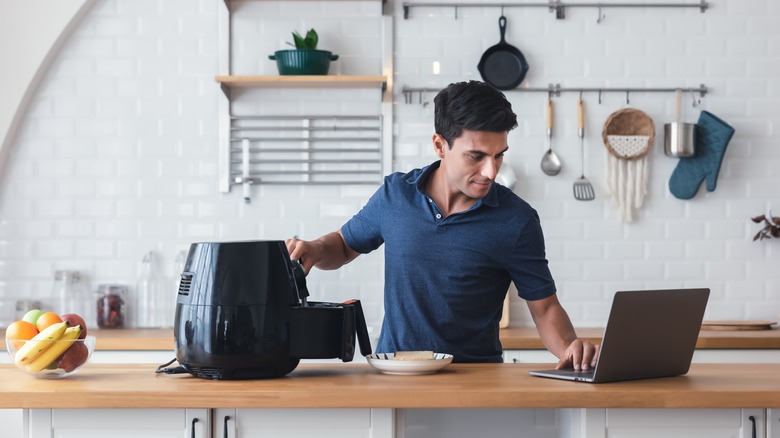The Simplest Way To Dry Fruit Without A Dehydrator
With its naturally sweet flavor, dried fruit can be a healthy snack between meals or when you're on the go. The key is to enjoy it in moderation. Banana chips, dates, figs, raisins, and other dried fruits are rich in fiber and antioxidants, but they also contain a lot of sugar in the form of fructose. "Consider dried fruit a treat," said registered dietitian Amy Shapiro, MS, RD, CDN, in a January interview with Real Simple.
As Shapiro points out, some packaged dried fruit options contain added sugar and preservatives, such as sulfites. This increases the calorie count and could take a toll on your health over time. Your best bet is to dry fruit at home and then enjoy it as-is or use it in your favorite recipes. For example, you could add dried fruit to granola, homemade protein bars, oatmeal, trail mixes, or banana bread.
While there are several ways to dry fruit, most people prefer to use a dehydrator for its convenience. Another option is sun drying, but it takes a lot of prep work, notes the University of California. However, you don't need a dehydrator or perfect weather to make dried fruits. Instead, consider using your oven to streamline the process.
How to dry fruit using just an oven
DIY dried fruit is cheaper (and often better for you) than store-bought versions, as you have full control over the ingredients used. A simple yet delicious recipe comes from Martha Stewart. First, you'll prepare the fruits you want to use, such as plums, figs, apricots, and grapes. Remove the pits, seeds, and stems, cut the fruits in half or smaller pieces, and place them on a baking sheet in a pan. Meanwhile, heat the oven to 225 F and then dry the fruits for 150 minutes to four hours, depending on their type and size.
The original recipe calls for sugar, but you can skip this ingredient. Plums, figs, and other fruits are sweet enough by themselves, so you may not want to add sugar. As a rule of thumb, place the fruits about 0.5 to 1 inch apart to prevent them from sticking together. Check them every 30 minutes or so, and remove those that appear to be fully dried. For example, banana chips should have a chewy texture and a caramel-like color, whereas dried berries will have no visible moisture, notes Ohio State University. Pineapples should have a spongy consistency when dried, but plums will have a leathery feel.
Cookbook author Stacey Ballis recommends starting with a low temperature, such as 150-200 F (per MyRecipes). If you go this route, you can let the fruits dry overnight. However, the ideal oven temperature depends on the type of fruit you're using.
You can use your air fryer to save time
Drying fruit in the oven couldn't be easier, but it takes a lot of time. If you're in a rush, you can use your air fryer to speed things up. While there are some types of foods you should never cook in an air fryer, this gadget is ideal for drying apples, mangos, strawberries, oranges, and other fruits. For example, you could use it to make dried orange slices in as little as 45 minutes, suggests Homes & Gardens (assuming your air fryer has a dehydrating function, that is).
The prep work is quite straightforward. First, you'll wash the fruits and cut them into pieces. Then, just preheat the air fryer, line the rack or basket with baking paper, and place the fruits inside it. "Thinner slices (1/4”) will dehydrate faster and can give you a crispier texture. Meanwhile, thicker slices (1/2" or thicker) will take longer and can provide a chewier texture," personal chef Jaclyn Huff said to Well + Good in June 2022. After that, you'll set the desired cooking temperature, which should be around 135 F for most types of fruits.
Huff recommends adding any flavors before you dehydrate the fruit. If, say, you want to add cinnamon or vanilla, sprinkle it over the fruits beforehand. You can also squeeze fresh lemon juice over them to reduce oxidation and keep them from darkening. When you're done, allow the fruits to cool and then store them in airtight containers.


